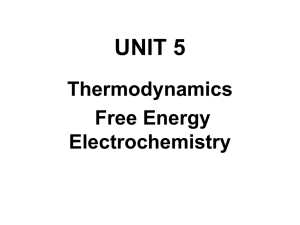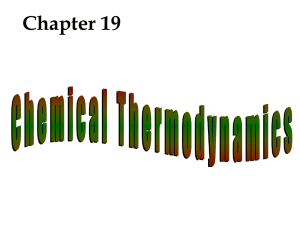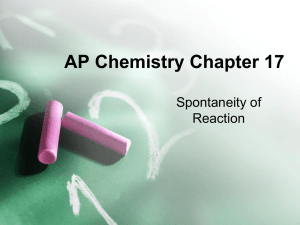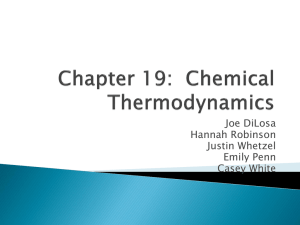Thermo applications
advertisement
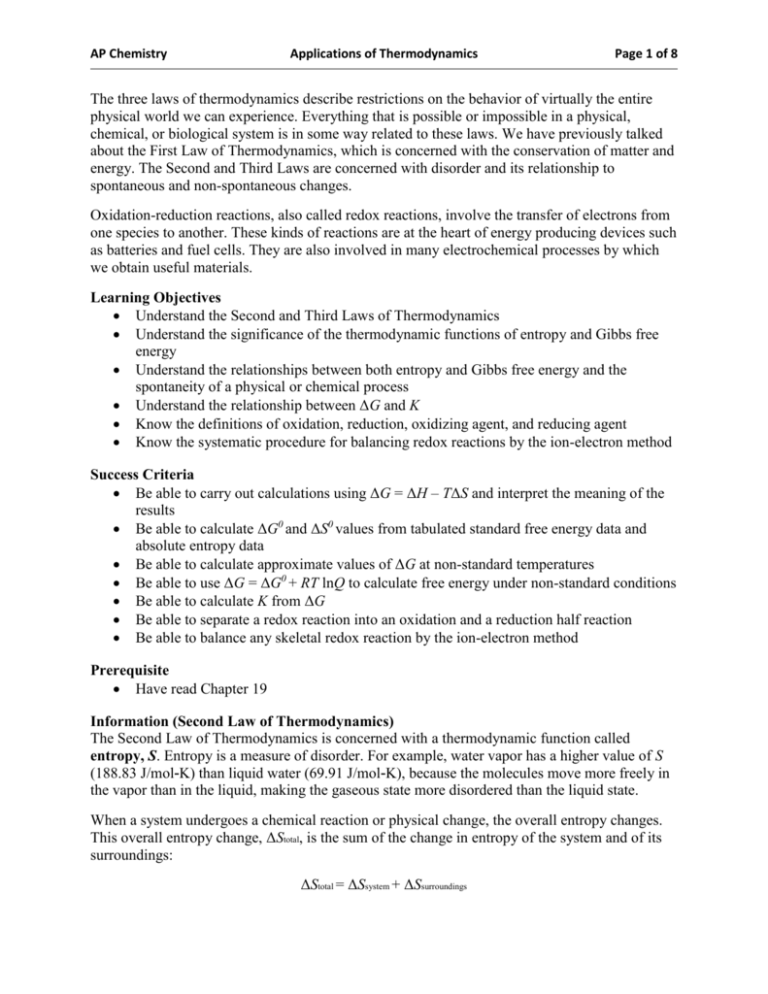
AP Chemistry Applications of Thermodynamics Page 1 of 8 The three laws of thermodynamics describe restrictions on the behavior of virtually the entire physical world we can experience. Everything that is possible or impossible in a physical, chemical, or biological system is in some way related to these laws. We have previously talked about the First Law of Thermodynamics, which is concerned with the conservation of matter and energy. The Second and Third Laws are concerned with disorder and its relationship to spontaneous and non-spontaneous changes. Oxidation-reduction reactions, also called redox reactions, involve the transfer of electrons from one species to another. These kinds of reactions are at the heart of energy producing devices such as batteries and fuel cells. They are also involved in many electrochemical processes by which we obtain useful materials. Learning Objectives Understand the Second and Third Laws of Thermodynamics Understand the significance of the thermodynamic functions of entropy and Gibbs free energy Understand the relationships between both entropy and Gibbs free energy and the spontaneity of a physical or chemical process Understand the relationship between ΔG and K Know the definitions of oxidation, reduction, oxidizing agent, and reducing agent Know the systematic procedure for balancing redox reactions by the ion-electron method Success Criteria Be able to carry out calculations using ΔG = ΔH – TΔS and interpret the meaning of the results Be able to calculate ΔG0 and ΔS0 values from tabulated standard free energy data and absolute entropy data Be able to calculate approximate values of ΔG at non-standard temperatures Be able to use ΔG = ΔG0 + RT lnQ to calculate free energy under non-standard conditions Be able to calculate K from ΔG Be able to separate a redox reaction into an oxidation and a reduction half reaction Be able to balance any skeletal redox reaction by the ion-electron method Prerequisite Have read Chapter 19 Information (Second Law of Thermodynamics) The Second Law of Thermodynamics is concerned with a thermodynamic function called entropy, S. Entropy is a measure of disorder. For example, water vapor has a higher value of S (188.83 J/mol-K) than liquid water (69.91 J/mol-K), because the molecules move more freely in the vapor than in the liquid, making the gaseous state more disordered than the liquid state. When a system undergoes a chemical reaction or physical change, the overall entropy changes. This overall entropy change, ΔStotal, is the sum of the change in entropy of the system and of its surroundings: ΔStotal = ΔSsystem + ΔSsurroundings AP Chemistry Applications of Thermodynamics Page 2 of 8 Some changes occur spontaneously, and others must be forced. A change to a more disordered state is a more probably event, so when a change occurs spontaneously there is an increase in the total entropy. This is the essence of the Second Law of Thermodynamics: Every spontaneous change results in an increase in total entropy. The great physical chemist Rudolph Clausius (1822-1888) famously summarized both the First and Second Laws as follows: The energy of the world is a constant; the entropy strives for a maximum. Unlike enthalpy, H, which is governed by the First Law of Thermodynamics, a change in the entropy of the system, which is governed by the Second Law, does not require an equal and opposite change in the surroundings. Some changes only involve an entropy change of the system, but more often we encounter processes that involve entropy changes for both the system and its surroundings. The Second Law only requires that the total entropy must increase for a spontaneous change. Therefore, in a spontaneous process, it is possible for the system to decrease in entropy so long as the surroundings undergo a greater increase in entropy, and vice versa. For example, water freezes spontaneously below its freezing point temperature, even though ice is a more ordered state (ΔSsystem < 0). As freezing occurs, the water liberates heat (equal to its heat of fusion) to the surroundings, causing greater thermal motion and more disorder in the molecules of the surroundings (ΔSsurroundings > 0). This represents a greater increase in entropy for the surroundings than the decrease in entropy from the ordering of water molecules in the ice (the system), so the total entropy change is positive (ΔStotal > 0). Key Questions 1. Does the entropy of the system increase or decrease for the following changes? Indicate whether ΔSsystem > 0 or ΔSsystem < 0. a. Water is boiled ΔSsystem > 0 ΔSsystem < 0 b. CaCO3(s) → CaO(s) + CO2(g) ΔSsystem > 0 ΔSsystem < 0 c. N2(g) + 3 H2(g) → 2 NH3(g) ΔSsystem > 0 ΔSsystem < 0 Information (Gibbs Free Energy) For a chemical reaction run at constant temperature and pressure, the reaction’s effect on the entropy of the surroundings can be calculated by the equation ΔSsurroundings = –ΔH/T The ΔH is the enthalpy change of the system, which transfers heat to or from the surroundings. The negative sign is inserted in the equation above to show the effect on the surroundings. Note that if ΔH is negative, the entropy change for the surroundings will be positive, favoring a spontaneous process. This is consistent with the observation that many exothermic reactions occur spontaneously. However, not all exothermic reactions occur spontaneously, and not all AP Chemistry Applications of Thermodynamics Page 3 of 8 endothermic reactions occur non-spontaneously. Recall that it is the total entropy change, ΔStotal, that determines whether or not a reaction will be spontaneous. As we have seen, ΔStotal = ΔSsystem + ΔSsurroundings. Substituting the expression –ΔH/T for ΔSsurroundings, we may write ΔStotal = ΔSsystem – ΔH/T Multiplying through by –T and defining ΔSsystem = ΔS, this may be rewritten –TΔStotal = –TΔSsystem + ΔH = ΔH – TΔS We can replace –TΔStotal with a function first proposed by the American mathematician J. Willard Gibbs (1839-1903), called the Gibbs free energy, G: G = H – TS For a chemical reaction at constant pressure and temperature, we define the change in Gibbs free energy as ΔG = –TΔStotal. Thus, our previous equation, –TΔStotal = ΔH – TΔS, becomes ΔG = ΔH – TΔS where all terms refer to the system. The sign convention for ΔG is consistent with what we have seen for other energy terms (ΔE, ΔH), by which heat is liberated when the sign is negative. Because ΔG is defined on the basis of –TΔStotal,, and because ΔStotal indicates whether or not a reaction is spontaneous, we can make the following generalizations regarding the sign of ΔG: If ΔG < 0, the reaction is spontaneous as written. If ΔG > 0, the reaction is non-spontaneous as written, but is spontaneous in the reverse direction. If ΔG = 0, the reaction is at equilibrium. From ΔG = ΔH – TΔS, we can see the factors that favor a spontaneous reaction: Reactions with ΔH < 0 (exothermic) favor spontaneity. Reactions that increase randomness (ΔS > 0) favor spontaneity. These two factors may work in opposition in certain cases, and the spontaneity determined from calculating ΔG = ΔH – TΔS depends upon the relative magnitudes of ΔH and TΔS. Key Questions 2. Fill in the missing values for the following reactions occurring at 25°C (298 K), and determine if the reaction is spontaneous or non-spontaneous. Reaction H2(g) + Br2(g) → 2 HBr(g) 2 H2(g) + O2(g) → 2 H2O(l) 2 N2(g) + O2(g) → 2 N2O(g) N2O4(g) → 2 NO2(g) ΔH (kJ/mol) –72.46 –571.66 +163.2 +58.02 ΔS (J/mol-K) +114.09 –326.34 –147.99 +176.61 ΔG (kJ/mol) Spontaneous? AP Chemistry Applications of Thermodynamics Page 4 of 8 Information (Standard Gibbs Free Energy of Formation) Like enthalpy, we can define a standard Gibbs Free Energy of formation, ∆𝐺𝑓0 , which is the value of ΔG0 when one mole of the substance in its standard state is formed from the stoichiometric amounts of its component elements, each in their standard states. As with ∆𝐻𝑓0, the standard state is 25°C (298 K) and 1 atm. These values of ∆𝐺𝑓0 can be used in the same way we used, ∆𝐻𝑓0 values to calculate the change for an overall reaction; i.e., ∆𝐺 0 = ∑ 𝑛∆𝐺𝑓0 (𝑝𝑟𝑜𝑑𝑢𝑐𝑡𝑠) − ∑ 𝑚∆𝐺𝑓0 (𝑟𝑒𝑎𝑐𝑡𝑎𝑛𝑡𝑠) where n and m are the stoichiometric coefficients for each product and reactant, respectively. As with ∆𝐻𝑓0, ∆𝐺𝑓0 = 0 for all elements in their standard states. Key Question 3. Given the following ∆𝐺𝑓0 values, calculate the standard free energy for the combustion of one mole of C2H6(g), and determine if the reaction is spontaneous or non-spontaneous: C2H6(g) H2O(l) CO2(g) –32.9 kJ –237.1 kJ –394.4 kJ ΔG0 = spontaneous kJ/mol nonspontaneous Information (Absolute Entropies and the Third Law) If we lower the temperature of a substance, molecular motion will be diminished and greater ordering will occur. At a temperature of absolute zero we might suppose that a perfect crystal, representing the ultimate order, would have an absolute entropy of zero (S = 0). This reasoning lead Walther Nernst in 1906 to formulate what is known as the Third Law of Thermodynamics: At the absolute zero of temperature, a perfect crystalline substance would have an absolute entropy of zero. But absolute zero is an unattainable temperature and no substance forms a perfect crystal, so all substances have non-zero absolute entropies at all real temperatures. Unlike enthalpy and free energy, absolute entropies, S, can be defined and calculated. Values are obtained from the temperature variation of heat capacities. However, when using these, it is important to realize that absolute entropies are not changes in entropy, ΔS. The standard absolute entropy of a substance, S0, is the entropy of the substance in its standard state at 25°C (298 K) and 1 atm. By the Third Law of Thermodynamics, these values are always AP Chemistry Applications of Thermodynamics Page 5 of 8 positive numbers; i.e., S0 > 0. The change in entropy under standard condition for a reaction, ΔSo, can be calculated from absolute standard entropy data as ∆𝑆 0 = ∑ 𝑛𝑆𝑓0 (𝑝𝑟𝑜𝑑𝑢𝑐𝑡𝑠) − ∑ 𝑚𝑆𝑓0 (𝑟𝑒𝑎𝑐𝑡𝑎𝑛𝑡𝑠) where n and m are the stoichiometric coefficients for each product and reactant, respectively. Note, that the absolute entropy of an element is not zero, and the absolute entropy of a compound cannot be calculated from the absolute entropies of its elements. Standard absolute entropies of substances are routinely tabulated along with with ∆𝐻𝑓0 and ∆𝐺𝑓0 data. Key Questions 4. Calculate ΔH0, ΔS0, and ΔG0 for the following reaction at 25°C (298 K). 2 H2O2(l) → 2 H2O(l) + O2(g) Given the following data: Substance H2O(l) O2(g) H2O2(l) ΔH0 (kJ/mol) –285.83 0 –187.8 S0 (J/mol-K) 69.91 205.0 109.6 ΔH0 = kJ/mol ΔS0 = J/mol-K ΔG0 = kJ/mol Information (Gibbs Free Energy and Temperature) From the relationship ΔG = ΔH – TΔS, we can see that the value of the Gibbs free energy of a reaction depends upon the absolute temperature, T. But the values for ΔH and S generally show only small changes with temperature. This allows us to use data for ΔH0 and S0 to estimate ΔG values at non-standard temperatures (i.e., T ≠ 298 K). When we use ΔH0 and S0 values at nonstandard temperatures, however, we should realize that the ΔG values obtained are only estimates. Nonetheless, these values usually lead to correct deductions about a reaction’s spontaneity at or near the chosen temperature. AP Chemistry Applications of Thermodynamics Page 6 of 8 Key Questions 5. Consider the reaction CaCO3(s) → CaO(s) + CO2(g) for which ΔH0 = +178.1 kJ/mol, ΔG0 = +130.2 kJ/mol, and ΔS0 = +160.5 J/mol-K. a. Is this reaction spontaneous at 25°C (298 K)? b. Assuming that ΔH and ΔS do not change significantly with changing temperature, is this reaction spontaneous at 1200 K? 6. For the vaporization of cyclohexane, C6H12(l) = C6H12(g) ΔH0 = +33.1 kJ/mol and ΔS0 = 93.84 J/K-mol. Assuming that these values do not change significantly with increasing temperature, estimate the boiling point temperature of cyclohexane. [Hint: Recall that boiling means that the liquid and vapor are in equilibrium, and therefore ΔG = 0.] Tboiling = K Information (Calculating ΔG Under Non-Standard Conditions) Tabulated data for Gibbs free energies are values under standard conditions. Very often we are interested in a chemical system under non-standard conditions. The value of ΔG under nonstandard conditions can be calculated from ΔG0 by the equation ΔG = ΔG0 + RT lnQ in which R = 8.314 J/K-mol, T is in units of kelvin, and Q is the reaction quotient, which we defined in our discussions of the equilibrium constant. Recall that Q has the same form as K, except the concentrations or pressures are not assumed to be equilibrium values. Under standard conditions, all substances have unit activities; i.e., their effective concentrations are 1. This means that under standard conditions, all concentrations and pressures in the Q AP Chemistry Applications of Thermodynamics Page 7 of 8 expression are 1, so ln Q = ln (1) = 0. Thus, under standard conditions the equation ΔG = ΔG0 + RT lnQ reduces to ΔG = ΔG0, as it should. But most often we deal with chemical systems in which the concentrations and pressures of reactant and product species are not 1, even at 25°C (298 K). To calculate ΔG under such non-standard conditions of concentration and pressure, we need to evaluate Q and use ΔG = ΔG0 + RT lnQ. Key Questions 7. Under standard conditions, ΔG0 = –32.74 kJ/mol for the reaction N2(g) + 3 H2(g) = 2 NH3(g) What is the value of ΔG for the reaction at 298 K when the partial pressures of a mixture are 0.0100 atm for N2(g), 0.0100 atm for H2(g), and 5.00 atm for NH3(g)? Is the reaction spontaneous or non-spontaneous under these conditions? ΔG0 = spontaneous kJ/mol nonspontaneous Information (Free Energy and the Equilibrium Constant) At equilibrium, ΔG = 0 and Q = K. We can use these restrictions to derive the relationship between ΔG and K from ΔG = ΔGo + RT lnK = 0. Rearranging, we have ΔGo = –RT lnK from which we obtain 𝐾 = 𝑒 −∆𝐺 0 /𝑅𝑇 We see the following generalizations from these equations: ΔGo > 0 ΔGo = 0 ΔGo < 0 K<1 K=1 K>1 K in this equation is the thermodynamic equilibrium constant, defined in terms of the activities of participants in their standard states. This rigorous form of K inherently has no units. For gas phase reactions, K is approximately Kp, because the standard state of gas species at 25°C (298 K) is defined in terms of one atmosphere. Otherwise, the type of K calculated from ΔGo depends upon the definition of standard states used in the determination of the Gibbs free energy. If all AP Chemistry Applications of Thermodynamics Page 8 of 8 reactants and products are ions in solution, K approximately corresponds to Kc, because the standard state of ions in solution is defined at 25°C (298 K) in terms of mol/L. Key Question 8. Under standard conditions, ΔG0 = -32.74 kJ for the reaction N2(g) + 3 H2(g) = 2 NH3(g). What is the value of K, the thermodynamic equilibrium constant, at 25°C (298 K)? K=



